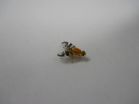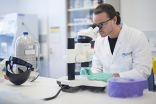(Press-News.org) In terms of duration of treatment and cost, patients with early stage breast cancer may benefit from accelerated partial breast irradiation (APBI) with proton therapy versus whole breast irradiation (WBI), according to new research from The University of Texas MD Anderson Proton Therapy Center.
In a cost analysis study based on typical patient characteristics, researchers used Medicare reimbursement codes to analyze allowable charges for eight different types of partial and whole breast irradiation therapies and treatment schedules available to early stage breast cancer patients. Taken together, these represent roughly 98% of the treatment options available to these patients. The cost of proton therapy when used for APBI, introduced to decrease overall treatment time and toxicity, was estimated at $13,833. Comparatively, WBI using IMRT (x-ray) therapy resulted in the highest Medicare charges at $19,599. The average charges across the eight treatment regimens were $12,784; thus, proton costs were similar to that of other types of radiation.
The findings were presented at the inaugural North America meeting of the Particle Therapy Co-Operative Group (PTCOG) held at MD Anderson Proton Therapy Center. A manuscript detailing the study findings is underway.
"It is often suggested that trials of proton APBI are irrelevant due to the modality's presumed high cost, but our data shows that this perception is false. Correcting this perpetual assumption is an important step in helping patients obtain the necessary health coverage to participate in clinical research," said Valentina Ovalle, M.D., postdoctoral research fellow and principal investigator. "Further, we anticipate that because charges vary proportionately across payers, the estimated Medicare reimbursement costs likely reflect relative charges to other third-party payers."
The American Cancer Society estimates that 232,670 patients will be diagnosed with invasive breast cancer this year. Early breast cancer (stage I or II) is the most common invasive breast cancer in the U.S. With treatment, these patients generally have a good prognosis. Standard treatment approaches typically include breast-conserving surgery (BCS) followed by radiation therapy for the entire breast – five days per week, for up to six weeks, including one week of "boost" radiation to the area where the initial tumor was removed.
The role of APBI for early stage breast cancer is still being evaluated, but its intent is to deliver a highly effective dose of radiation while greatly reducing treatment time – 10 treatments twice per day over one week. Further, on average it spares at least two-thirds of breast tissue from a full dose of radiation.
"The biggest drawback to WBI is that it is inconvenient, interrupting lives," said Eric A. Strom, M.D, F.A.C.R., study co-author and professor in Radiation Oncology. Strom is the principal investigator of a clinical trial sponsored by the National Cancer Institute on proton APBI.
APBI is delivered via two approaches – brachytherapy and external beam. Proton therapy is offered as a type of external beam APBI and, according to Strom, is unique in its ability to provide the full dose of radiation precisely to the tumor site and nowhere else, eliminating radiation to the remaining breast, lung and heart. To date, research on proton APBI has shown effective tumor control, limited side effects and good cosmetic outcomes.
"This cost analysis must be interpreted in light of clinical evidence for proton APBI, which while still in nascent stages, is promising," said Ovalle. "The findings counter the presumption that proton APBI is so expensive that even excellent clinical results would be immaterial. If the payment barrier for proton therapy is removed so that current and future research can proceed, the outcomes may ultimately benefit patients, physicians and insurers: better treatments at lower costs."
INFORMATION:
Other MD Anderson researchers contributing to this study include Joy Godby, B.A., Simona F. Shaitelman, M.D., Ed.M., Henry M. Kuerer, M.D., Ph.D., Wendy A. Woodward, M.D., Ph.D, and Karen E. Hoffman, M.D., M.H.Sc., M.P.H.
Proton therapy shown to be less costly than some alternative radiotherapy techniques
Findings may challenge assumption that proton therapy is more costly than other traditional treatments and supports case for insurance coverage
2014-10-31
ELSE PRESS RELEASES FROM THIS DATE:
Green spaces don't ensure biodiversity in urban areas
2014-10-31
Planting trees and creating green space in cities is good for attracting species, but it may not be enough to ensure biodiversity in built environments, a University of Iowa study has found.
The researchers surveyed two types of tree in an urban area in Iowa, and recorded the abundance of two insects that interact with them. They found that while there were plenty of the trees, black cherry and black walnut, they didn't find a corresponding abundance of the insects, in this case fruit flies that feed on the walnuts and black cherries and a type of wasp that feeds on the ...
Improved mouse model will accelerate research on potential Ebola vaccines, treatments
2014-10-31
In the war against Ebola one important hurdle has just been cleared – by a mouse.
Researchers at the University of North Carolina at Chapel Hill and colleagues have developed the first genetic strain of mice that can be infected with Ebola and display symptoms similar to those that humans experience. This work, published in the current issue of Science, will significantly improve basic research on Ebola treatments and vaccines, which are desperately needed to curb the worldwide public health and economic toll of the disease.
"You can't look for a cure for Ebola ...
Scientists trigger self-destruct switch in lung cancer cells
2014-10-31
CANCER RESEARCH UK scientists have found a drug combination that can trigger the self-destruct process in lung cancer cells - paving the way for new treatments, according to research that will be presented at the National Cancer Research Institute (NCRI) Cancer Conference in Liverpool next week*.
When healthy cells are no longer useful they initiate a chain of events culminating in self destruction. But cancer cells swerve away from this suicide path and become immortal. This means that cells grow out of control – causing tumours to form.
The Cancer Research UK ...
Tropical Depression Nuri now haunting the western Pacific Ocean
2014-10-31
Tropical Depression Nuri formed on Halloween morning, October 31, and is haunting the waters of the western North Pacific Ocean. NASA-NOAA's Suomi NPP satellite captured a ghostly-white image of the storm.
When Suomi NPP flew over Tropical Depression Nuri on Oct. 31 at 3:36 UTC, the Visible Infrared Imaging Radiometer Suite or VIIRS instrument aboard captured an infrared image of the storm. The infrared data shows temperature, an indicated that there were very high thunderstorms with very cold cloud top temperatures surrounding the center of the low level circulation ...
Strange, fanged deer persists in Afghanistan
2014-10-31
WCS study confirms that endangered musk deer still live in Nuristan Province – some 60 years after last sighting
Species targeted by poachers: Musk deer scent glands are more valuable than gold
Study appears in the October issue of the journal Oryx
NEW YORK (October 31, 2014) – More than 60 years after its last confirmed sighting, a strange deer with vampire-like fangs still persists in the rugged forested slopes of northeast Afghanistan according to a research team led by the Wildlife Conservation Society (WCS), which confirmed the species presence during ...
A matter of life and death: Cell death proteins key to fighting disease
2014-10-31
Melbourne researchers have uncovered key steps involved in programmed cell death, offering new targets for the treatment of diseases including lupus, cancers and neurodegenerative diseases.
The research teams from the Walter and Eliza Hall Institute worked together to discover the three-dimensional structure of a key cell death protein called Bak and reveal the first steps in how it causes cell death. Their studies were published in Molecular Cell and Proceedings of the National Academy of Sciences.
Programmed cell death, known as apoptosis, occurs naturally when ...
New step towards eradication of H5N1 bird flu
2014-10-31
A University of Adelaide-led project has developed a new test that can distinguish between birds that have been vaccinated against the H5N1 strain of avian influenza virus or "bird flu" with those that have been naturally infected.
This is a significant step in the fight against this often fatal strain of avian influenza which is widespread in the poultry populations of South East Asia, particularly Indonesia and Vietnam.
It causes global concern because of its possible transmission to humans and the threat of a pandemic if it mutates to a form that can be easily passed ...
'Divide and rule' -- raven politics
2014-10-31
Thomas Bugnyar and his team have been studying the behavior of approximately 300 wild ravens in the Northern Austrian Alps for years. They observed that ravens slowly build alliances through affiliative interactions such as grooming and playing. However, they also observed that these affiliative interactions were regularly interrupted by a third individual. Although in about 50 % of the cases these interventions were successful and broke up the two affiliating ravens, intervening can be potentially risky when the two affiliating ravens team up and chase away the intervening ...
Efficient genetic editing
2014-10-31
As potential next-generation therapeutics and research tools, few life sciences technologies hold more promise than genome-editing proteins – molecules that can be programmed to alter specific genes in order to treat or even cure genetic diseases.
There's at least one catch though – getting genome-editing proteins into cells, where they need to be to access the genome, is a major challenge, especially in live animals or human patients.
Conventionally, researchers have delivered the DNA encoding these genome-editing proteins into cells and then relied on ...
Countries can learn from Cyprus' 2013 economic crash, according to Imperial report
2014-10-31
In March 2013, Cyprus agreed to a €17 billion (£13.42 billion) international bailout by the International Monetary Fund (IMF), the European Central Bank (ECB) and the European Commission (EC).
The magnitude of the bailout was 100 per cent of Gross Domestic Product (GDP) and also involved a bank bail in. This is when the borrower's creditors are forced to bear some of the burden by having a portion of their debt written off in order for the bank to have sustainable level of debt.
The package of measures was aimed at preventing the country from facing the ...
LAST 30 PRESS RELEASES:
Making lighter work of calculating fluid and heat flow
Normalizing blood sugar can halve heart attack risk
Lowering blood sugar cuts heart attack risk in people with prediabetes
Study links genetic variants to risk of blinding eye disease in premature infants
Non-opioid ‘pain sponge’ therapy halts cartilage degeneration and relieves chronic pain
AI can pick up cultural values by mimicking how kids learn
China’s ecological redlines offer fast track to 30 x 30 global conservation goal
Invisible indoor threats: emerging household contaminants and their growing risks to human health
Adding antibody treatment to chemo boosts outcomes for children with rare cancer
Germline pathogenic variants among women without a history of breast cancer
Tanning beds triple melanoma risk, potentially causing broad DNA damage
Unique bond identified as key to viral infection speed
Indoor tanning makes youthful skin much older on a genetic level
Mouse model sheds new light on the causes and potential solutions to human GI problems linked to muscular dystrophy
The Journal of Nuclear Medicine ahead-of-print tip sheet: December 12, 2025
Smarter tools for peering into the microscopic world
Applications open for funding to conduct research in the Kinsey Institute archives
Global measure underestimates the severity of food insecurity
Child survivors of critical illness are missing out on timely follow up care
Risk-based vs annual breast cancer screening / the WISDOM randomized clinical trial
University of Toronto launches Electric Vehicle Innovation Ontario to accelerate advanced EV technologies and build Canada’s innovation advantage
Early relapse predicts poor outcomes in aggressive blood cancer
American College of Lifestyle Medicine applauds two CMS models aligned with lifestyle medicine practice and reimbursement
Clinical trial finds cannabis use not a barrier to quitting nicotine vaping
Supplemental nutrition assistance program policies and food insecurity
Switching immune cells to “night mode” could limit damage after a heart attack, study suggests
URI-based Global RIghts Project report spotlights continued troubling trends in worldwide inhumane treatment
Neutrophils are less aggressive at night, explaining why nighttime heart attacks cause less damage than daytime events
Menopausal hormone therapy may not pose breast cancer risk for women with BRCA mutations
Mobile health tool may improve quality of life for adolescent and young adult breast cancer survivors
[Press-News.org] Proton therapy shown to be less costly than some alternative radiotherapy techniquesFindings may challenge assumption that proton therapy is more costly than other traditional treatments and supports case for insurance coverage






